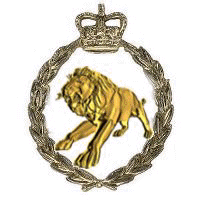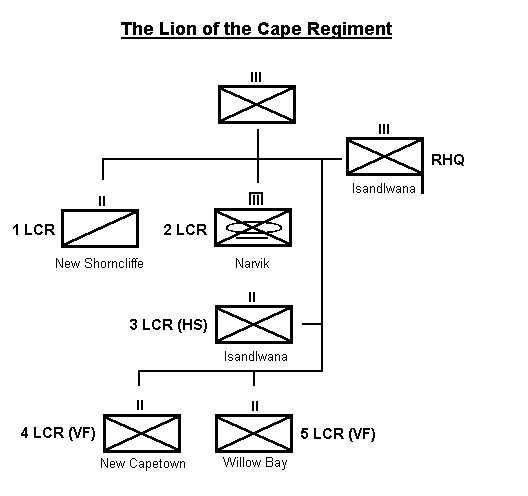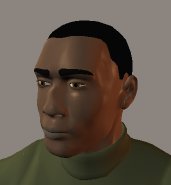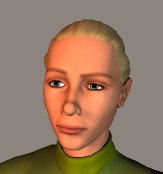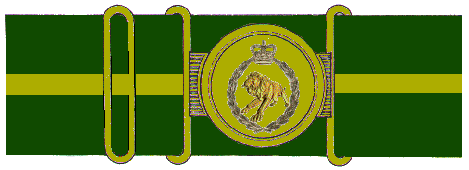Wellon Army: 2300AD
The Lion of the Cape Regiment Introduction The Lion of the Cape Regiment, or LCR, is an infantry regiment of the Wellon Army. It is recruited predominantly from the area of the Lion Cape and the city of New Capetown on the edge of the Golden Bay. The regiment, like the area it recruits from, is particularly multi-cultural with a large number of soldiers of Southern African extraction in its ranks. As a result the regiment has a substantially different culture and traditions than other regiments of the Wellon Army. The LCR has five battalions, two of Permanent Force soldiers, one Home Service battalion with a high proportion of PF soldiers reinforced by high-readiness Volunteer Force soldiers, and two Volunteer Force battalions. Of the regular battalions, the 1st Battalion serves with 13th Armoured Division's Recce Group stationed near Riverside. The 2nd Battalion is now in the mechanised role and has just returned from serving with the British 1st Light Brigade on BCV-4 where it has seen fierce fighting against the Kafers. The regiment is the first Wellon Army formation to win battle honours and two of its soldiers have been awarded the Victoria Cross. Consequently the unit represents the start of a new Wellonese tradition of off-world military service and has become, for the time being, the most famous regiment in Wellon. Narrative On the 14th of April 2302 Corporal Johnson Khumalo was in command of the Anti-Tank Platoon detachment screening a raid in force by C Company, 2 LCR Battlegroup on a Kafer laager in New Africa's lower Fedren Valley. Whilst the raid was initially very successful Kafer resistance hardened and C Company began to withdraw after laying explosives in the laager's supply dump. The Kafer counter-attack became more serious as a armoured Kafer force from the upper Fedren arrived on the scene. Corporal Khumalo led his four missile armed vehicles against the Kafer unit and inflicted severe casualties against their exposed flank. He successfully distracted the force from the retreating C Company, however the alien reaction was fierce. Corporal Khumalo's force took immediate casualties with one element being surrounded and destroyed. Although presented with the opportunity to withdraw Corporal Khumalo inspired his remaining men to return to the fight and continue to protect C Company now loading on its drop zone. Eventually Corporal Khumalo's vehicle was hit and he was badly injured. He was evacuated in the section's remaining vehicle but died before he could reach medical aid. Corporal Khumalo was a popular soldier whose personal bravery, leadership and example allowed the escape of C Company in the face of serious odds. His own small unit destroyed many Kafer vehicles including two of the feared 'Deathsleds' as well as many foot soldiers. Khumalo was personally responsible for many of the vehicle kills. His valorous conduct in this action is deserving of this highest reward. Extract from Victoria Cross Citation in the New Camelot Gazette, 21 August 2302 'Johnny Khumalo? I can't say that I ever really liked the man. He was a bully, insubordinate and mostly downright idle. But when it came down to it he came up trumps, he was one of those soldiers war brings the best out of. In the Fedren Valley Raid he was immense. Make no bones about it he saved the Company. His section butchered that Kafer flying column with enfilaid fire to begin with, but they paid for it eventually. I saw his body when the last Hover Rover came back in. It was piled high with wounded and filled with blood. Whatever had hit him nearly cut him in two.' Interview with an un-named LCR Officer, 2 February 2303
The LCR traces its history to the formation of the Lion Cape Volunteer Regiment in 2180. Since the early 2170s mineral reserves had brought in the Anglo-Azanian Mining Company to the Lion Cape. The mostly Azanian and Zimbabwean workforce tended to settle in the area and the planned development of a city in the area was brought forward to avoid uncontrolled expansion. New Capetown grew quickly with service industries growing up to provide for the rich miners, soon its excellent climate and deep harbour would cause the city to generate its own momentum. With the establishment of the new city the Governor authorised a locally raised defence and civil emergency relief force for the area. This was the Lion Cape Volunteer Regiment. A British Army Training Team mostly drawn from the Royal Fusiliers of Wales was brought in to train the new formation. The LCR retains an affiliation with today's Royal Welch Fusiliers and Royal Regiment of Wales. The LCVR recruited from throughout the territory and was a part-time militia formation. In 2193 with the escalating situation of illegal colonisation in South Albion, the Governor-General of North Albion authorised a number of regular battalions to be raised from the territorial regiments for service in the South. One of these was the LCVR, which changed its name and insignia to better reflect its new role as a Permanent Force battalion. In 2195 the 1st Battalion, Lion of the Cape Regiment undertook its first of many tours of duty in the southern archipelago basing out of Point Sterling. The LCR continued in its twin roles of colonial defence and counter-insurgency for some time. The battalion in particular maintained its skills in bush warfare, which it practised assiduously when in its home areas, and as part of its recruit training. In 2241 the North Albion Defence Force, of which the LCR was a part became part of the Wellon Army when the Dominion of Wellon was created. A bigger change came when the 2nd Battalion, also PF, was formed in 2250, the 1st Battalion was at the same time fortunate to serve on a force-exchange posting with the British Army on Earth, and mounted ceremonial guard at Windsor and London as part of its duties. The LCR gained an excellent reputation within military circles for being well rooted in its community. In particularly it kept close links with the various militia units around the Lion Cape, such as the New Capetown Scottish, Robin Island Irregulars and Blood River Kommando by providing PF training personnel and exercise opportunities. The LCR was a totally multi-cultural regiment and suffered none of the inter-racial difficulties that were increasingly manifest in the region at the time. With the advent of Home Rule in 2277 the LCR took part in a range of exchanges with other Tiranean militaries designed to foster closer links. As such they still today maintain links with the Tundukubwan 14th Brigade and the Nouvelle Provençal 13e Régiment d' Infanterie de Marine (two soldiers from the LCR would serve with this unit during the Elysian War of Independence.) The main change to the LCR's way of doing things came in 2285 with that year’s Defence Review. The two battalions were to be joined by three further formations. These were to be a Home Service battalion (3rd), and a Volunteer Force battalion (5th) raised from the outlying rural areas of the Lion Cape. The 4th Battalion was the New Capetown Scottish militia unit brought into the LCR, but retaining some of its unique characteristics and traditions. Of these units only 5 LCR caused any real difficulties as two the companies raised in the Blood River and Robin Island areas were from Exclusionist communities and so exclusively black or white. The 3rd (HS) Battalion took over the local search and rescue role, at the same time as perfecting the bush warfare skills honed by the LCR over the years. In 2292 1 LCR rotated from 12th (Wellon) Armoured Division into 5 Mechanised Brigade, whilst 2 LCR moved from 5 Mech into 2 Light Brigade. The change was a major one for 2 LCR as it meant a large period of re-training and re-organisation. Foremost amongst these was the need for the whole battalion to under-go airborne training at the Para Battle Cadre in order to take up the full intervention role of the Light Brigade. Some of the battalion’s personnel were unable to complete this training and so were replaced by PF personnel from 1 or 3 LCR instead. However compared to some other battalions 2 LCR completed the change with no real dramas. As part of the Anglo-Wellon Force Exchange programme 2 LCR was chosen in 2298 to serve in the British 1st Light Brigade on BCV-4. A move that was ultimately to place the battalion in harms way during the Kafer Invasion of 2301/02. In 2302 1 LCR rotated from 5 Mechanised Brigade to the 2 Armoured Brigade as part of the newly formed 13th (Wellon) Armoured Division. Alongside 2 NAGJ the battalion was to become one of the first Wellonese divisional close reconnaissance units designed to provide long duration, long range patrol and observation capability to the division. The battalion has just finished its comprehensive training regime, having undertaken testing training in all of Wellon's environments and also cross-training with allied units. 2 LCR returned from Beta Canum to become part of 5 Mech Bde. 2 LCR is currently very weak with fewer than 150 pre-War soldiers in the ranks, however the fame of the battalion has resulted in a flood of new recruits for the battalion although these will take several years to fully integrate. In addition leadership cadres from the other battalions of the regiment have been posted in to stabilise the battalion. The 2nd Battalion LCR was attached to the British 1st Light Brigade during the Kafer War and became know as the 'Lions of New Africa' in the Wellon press. The battalion has now returned to Wellon after a short stint on Alicia. 2 LCR had spent eight months in combat on BCV-4, and was present and in combat for the Invasion, Occupation and Liberation of that planet. In which time it operated in a variety of combat roles from all-out assaults to guerrilla raiding. 2 LCR at the time was a light role battalion and as such was trained for intervention operations in the colonies or in the core. It moved to BCV-4 in 2298 for a four-year tour as part of the Force Exchange scheme between Britain and Wellon. The deployment went excellently with 2 LCR working well with British Light Infantrymen in the 1st Light Brigade and generating close links with the New African community. 2 LCR soon adapted their bush patrolling skills to function in New Africa's rain forests and generally speaking morale was excellent. 2 LCR was equipped with British issue equipment and re-organised identically to a British light battalion. The major change was a move to the more modern TISS-4F system, and the acquisition of a Combat Walker platoon within Support Company. At the time the Wellon Army had no CW assets of its own, although was beginning the process of bringing the Bowman into service. As a result similarly trained personnel from other Wellon Regiments as well as British soldiers supplemented LCR CW personnel trained in the UK, these soldiers came from 3 RRW, 1 RVR and 2 PSG. The level of casualties taken during the fighting caused the battalion to integrate New African volunteers into its ranks, and some 40 (some accompanied by dependants) have stayed with the battalion on its return to Wellon. The LCR recruits from throughout the Lion Cape region, with roughly equal numbers of soldiers coming from urban and rural areas. The battalion has a large number of ethnic groups within its ranks. Zulu, Xhosa and Shona soldiers made up the bulk of the original Lion Cape Volunteers and their descendants continue to provide around 50% of the LCR's troops. More recent additions have included Wellonese of British, Ndebele, White Azanian and British South African descent. The LCR officially conducts all of its business in English, but several languages can be heard being used within its ranks. Most of its soldiers are multi-lingual to some degree. Whilst the Lion Cape region has in recent years gained a reputation for racial intolerance based on the 'Exclusionist' communities and street violence in New Capetown, buts this has not spread to the ranks of the LCR. The mutual trust created by the LCR's own training in the harsh bush seems to remove much knee jerk intolerance. One possible exception is found in the attitudes between soldiers of White Azanian and British South African decent (those European South Africans whose families respectively stayed or left on majority rule) who continue to bicker with each other. Although it unwise to generalise about a unit like the LCR, officer ranks are drawn largely from Zulu, British and White Azanian (often Jewish) Wellonese communities. British South Africans and Ndebele are well represented in the NCO ranks. Other ranks are drawn from all the communities. Below: LCR shoulder patch.
Recruits to the LCR undergo the same training regime as most other Wellon infantrymen. Phase 1 training is undertaken alongside other Army, Aerospace and Navy recruits from the area, both PF and VF, at Isandlwana Barracks south of New Capetown. VF recruits continue their Phase 2 training at Isandlwana, whilst PF recruits spend six months at the North Albion Infantry Training Centre at Narvik Garrison near Victoria. When a PF recruit finishes his six months at NAITC he returns to Isandlwana where he becomes a member of the 3rd (HS) Battalion for a minimum of a further three months. Whilst not unique (several other regiments have similar programs) this bush training at the Schultz Training Area is a unifying element for the LCR. The bush warfare and long range patrolling skills taught in this period gives its recruits an excellent professionalism in the field and added esprit de corps. Once his time with 3 LCR has been undertaken, and passing out is at the discretion of instructors (one recruit remained with 3 LCR for three years before being sent to his regular battalion). Those going to other battalions must pass any specialist training cadres, especially in the case of 1 LCR. Continuation training in advanced military disciplines can be undertaken with individual battalion cadres or with 3 LCR or at a regional training centre. The LCR has a long-standing reputation within the Wellon Army for the standard of its musketry. The LCR tries to maintain this by training all of its Phase 1 recruits on the old 7.5mm Grafton CSR with iron sights. They have constantly found that soldiers trained on this hard recoiling weapon become excellent shots when using sophisticated weapons such as the issue L144A1 Enfield. Officer training involves undertaking the same initial basic training as any recruit, and an officer candidate can only go forward after an undefined period of service in the ranks. The LCR insists its officer candidates successfully undertake a Potential Officers Course of one month of field work in the arid bush at Isandlwana, before going on to Royal Military Academy New Camelot. The POC is reputedly very taxing, but the candidate who manages to pass POC rarely fails at RMANC. Potential NCO training is undertaken with similar rigorous preparatory courses and the LCR is proud of the number of 'Best Candidate' awards won by its soldiers at RMANC. The LCR takes its links with affiliated regiments very seriously and normally has at least four soldiers on exchange with each of the four affiliated units at any one time, and this is reciprocated. The LCR has fairly few soldiers that go on to serve in special forces, this is perhaps fostered by the units view of itself as something of an elite in the first place.
1st Battalion, The Lion of the Cape Regiment 1 LCR is currently a Permanent Force infantry close reconnaissance (CR) battalion of 13th Armoured Division's Divisional Recce Group and is based at Fulda Barracks in New Shorncliffe. The division is a conventional hover-mobile armoured division tasked to III (Wellon) Corps and the defence of Wellonese interests on Tirane. Due to the time required for the battalion to train for its role it has an extended ten year tour. 1 LCR has as its tasks the provision of information gathering teams capable of deep penetration, long duration missions in the FEBA (Forward Edge of Battlefield Area) and in the FEMZ (Forward Enemy Manoeuvre Zone.) The battalion's teams are trained for forward infiltration of lines in a variety of methods, generally this is done on foot or by small ACV vehicles. However on other occasions small boats, aircraft and even HALO/HAHO insertions can be attempted. In addition to infiltration skills the battalion is trained in the construction of OPs and the use of remote observation and communications equipment. Artillery and mortar fire control and target selection are also important parts of the unit's work. The CR battalion has a common organisational structure with most infantry battalions with three line companies, a Support company and a HQ company. However the company organisation is slightly different. A and B Companies are styled as 'general recce' companies and are composed of three 20 man platoons and a small HQ Element. Each of the platoons has four, four man recce teams and a four man command team, the platoon also has access to five heavily armed WMC Reynard III's for movement. C Company is the 'special recce' company sharing the same organisation but also being capable of more specialist insertion methods. Support Company includes a Drone Platoon and a Support Platoon. The Support Platoon is a large platoon with ten Reynard III's and is used to provide Immediate Reaction Support to the line companies as well as operating as a light element in a divisional anti-tank screen. HQ Company provides command, administrative and enhanced communications capability. 1 LCR is markedly smaller than most other types of battalion having only around 350 personnel. This allowed the battalion to 'cherry pick' its best soldiers when it re-roled with most of the remainder being re-assigned to fill in the gaps with 2 LCR. 2nd Battalion, The Lion of the Cape Regiment The highly decorated 2 LCR is currently a PF mechanised infantry battalion in 5 Mechanised Brigade based at Narvik. The battalion is a combined arms combat group based on the Dragoon family of vehicles and is composed of three company groups and a support company. With its three platoons of Dragoon tank-destroyers and two strong mobile Dragoon anti-tank missile carrier platoons is has impressive defensive firepower. The battalion is currently in the throws of re-building and re-organising since its return from the French Arm. It will be a long running program but aided by substantial drafts from 1 LCR it is presumed that the battalion will regain its proper combat effectiveness inside a year. 3rd (Home Service) Battalion, The Lion of the Cape Regiment 3 LCR is based at Isandlwana Barracks, which is the regimental home of the LCR (as well as 2 Western Brigade HQ). 3 LCR has two main roles, the usual home defence tasks as well as supplementary training for the other battalions. 3 LCR is highly skilled in bush warfare and tracking and as such it is often called on to perform search and rescue missions. Especially in the Colenso area where a team is always training or on stand-by in order to help rescue any downed airmen from the air force facilities there. 3 LCR also participates in the training of the RWAF Regiment's Air Commando Squadrons in survival techniques. In supplementary training tasks 3 LCR undertakes to increase the level of skills in fieldcraft and leadership of all ranks of the regiment who will periodically pass to 3 LCR to brush up their skills and drills. 3 LCR has one Training Company, and two large company sized Tracker Combat Units each composed of several Tracker Combat Teams composed of PF and VF personnel. However all of these units are capable of acting as conventional infantry companies when required. Its Support Company also runs training cadres for the other battalions. 4th (New Capetown Scottish) Battalion (VF), The Lion of the Cape Regiment 4 LCR is a Volunteer Force light role battalion that has been created from the old New Capetown Scottish militia battalion. 4 LCR is recruited entirely from urban New Capetown. 4 LCR is the only LCR unit with a band, naturally Pipes and Drums, and continues to hold on to its old traditions. 4 LCR works predominantly on foot or with all-terrain vehicles. It has four rifle companies, (including U Company, recruited from New Capetown's students), support company and HQ Company. 5th Battalion (VF), The Lion of the Cape Regiment 5 LCR is another VF light role battalion recruited from the rural parts of the Lion Cape Peninsular stretching from Robin Island, through the Blood River Valley onto the edge of the Dannon Valley. However this spread takes in several 'Exclusionist' communities so two of the companies are de-facto mono-cultural. In spite of this 5 LCR performs well on exercise although the regimental HQ wants to bring in more integration. 5 LCR also has a similar organisation to 4 LCR. Colonel Joseph Rankin, MP, DSO and Bar, MC Ret.
Joe Rankin was the CO of 2 LCR during the Kafer War. Col Rankin was born in New Capetown in 2262 to wealthy parents, his mother was an executive with a subsidiary of the Trans-Indi Corporation, his father the scion of one of New Capetown's founding families. Joe had something of a mobile up-bringing, and while he was packed off to a leading Meritshire boarding school he also frequently visited his parents working in various major cities throughout Tirane, although his father’s family home in New Capetown was a major base for the young Joe. Consequently Joe Rankin has a cosmopolitan outlook and is multi-lingual speaking English, fluent French, good German and has a smattering of Mandarin and Japanese. At 18 Joe Rankin finished his schooling and went to university, and although he had received firm offers from a range of prestigious universities including Ashton and Oxford he chose to attend the European University at Mont Royal. There he studied a range of subjects before graduating with a degree in Modern Languages. It was in his time at Mont Royal that Joe Rankin first began taking his first steps to a military career, when he joined the Tirailleurs de Mont Royal a local, French speaking territorial militia unit. Rankin then received a sponsorship from Anglo-Azanian Mining for him to study for an MBA at New Capetown University, where he also served in the ranks of the New Capetown Scottish. Rankin graduated from NCU with good grades but found his work with Anglo-Azanian to be somewhat boring and dissatisfying. So he looked instead to a permanent military career, joining the Lion of the Cape Regiment (which the New Capetown Scottish had become part of) as a private soldier in 2286. His previous militia service stood him in good stead and he passed his basic training with ease and was soon recognised as a potential officer. He attended his commissioning course at the Royal Military Academy, New Camelot in 2287 and he began a long association with the 2nd Battalion joining as a rifle platoon commander. Joe Rankin had a fairly standard career for a Wellon Army officer, serving at various times as Recce Platoon Commander, OC of B Coy 2 LCR and as Intelligence Officer for 1 LCR. Notably he served for two years as a company 2 i/c with the II/13e RIMa in Nouvelle Provance from 2295 to 2296. Late in 2301 he was transferred from his job on the Staff of 4 Mech Bde to become CO of 2 LCR after the death of the previous CO in a training accident. It was in this capacity that Rankin led the battalion in the New African campaign as a successful part of the British 1st Light Brigade. Joe Rankin is an easy going and likeable man, with a flair both for peacetime soldiering and unexpected risk-taking in wartime. He was able to swiftly realise that against the Kafers fairly large bodies of soldiers can operate unsupported in their rear-areas. It was this that allowed 2 LCR to pull off many meticulously planned and excecuted raids. Under his leadership 2 LCR gained its reputation for carrying out difficult tasks thanks to thorough preparation. His previous service as an Intelligence Officer for 1 LCR has given him an excellent understanding of this area of operational craft. As a result 2 LCR was supported by a wide range of locally recruited assets. On his return from BCV-4 Rankin became a prominent and outspoken proponent of Wellonese participation in the war. He became so outspoken that he retired his PF commission in order to stand for parliament. He was elected to a rural Lion Cape constituency as an independent MP with a landslide majority. He is now a rising political star, but remains a prominent member of the LCR family. Major Christian Mpande, DSO
Chris Mpande is the Officer Commanding C Company of 1 LCR. Chris Mpande was born in the middle-class Westwall suburb of New Capetown in 2271. His father was a NCO in 1 LCR who was invalided out of the battalion following an ambush on a patrol he was leading in the Southern Archipelago. Whilst reconstructive surgery saved his legs, Sunday Mpande was never to regain his full fitness. However whilst undergoing physical therapy he met the physiotherapist who would become his wife, and together they settled down in New Capetown. Chris Mpande undertook his schooling locally, but was always heavily influenced by his fathers military career, and joined the local cadets as soon as he was old enough. An excellent sportsman who represented New Capetown in both Rugby and Cricket he was also an bright and attentive scholar whilst remaining a popular member of the school community. Everything came easily to Chris Mpande, who grew to be tall, well built and good looking. Chris moved easily into an engineering degree at New Capetown University, and threw himself into extra curricula activities with a vengeance especially with U Coy of 4 LCR with whom he gained a TF commission in his third year. On graduating Chris transferred to PF service and was commissioned into 2 LCR in 2293. He rose rapidly, commanding a rifle platoon, being 2 i/c of a company, having a short stint as battalion Adjutant, then commanding 3 LCR's Tracker Combat Unit B before becoming OC of D (Patrols) Coy of 2 LCR in mid-2300 which he led during the Kafer War. Chris Mpande is almost the archetypal laid-back LCR Wellonese Zulu officer, whose rise has almost seemed effortless. However he is genuinely talented and works exceptionally hard behind the scenes to become a better officer. However the war on New Africa has hardened the previously easy-going officer, who pushes himself and his men as hard as possible. On his return from New Africa he was an obvious candidate for command of a company in 1 LCR and he received the prized C Company. Mpande has been marked out for further promotion. 2nd Lieutenant Oliver Dylan
2Lt Dylan is a Tracker Combat Team commander with 3 LCR’s TCU Alpha. He is one of the new generation of officers in the LCR, transferring across from other regiments drawn by the glamour of the Lions of New Africa. Oliver Dylan was born in Livingstone to wealthy English-Caribbean immigrants working in the LTA industry, he was educated and raised in that city before going to university at Riverside Tech. Dylan only became interested in a military career two years after graduation when he began to become disillusioned with his job. He enlisted in the Royal Wellon Engineers and was quickly brought onto the RWE's Quick Track for officers and was soon sent to RMANC. His time there coincided with the height of the Kafer War and like may Officer Candidates he became seduced by the legend of the Lions of New Africa. He applied to transfer to the LCR and after a period of service with a RWE regiment his wish was eventually granted. So far life with the LCR has not gone as he expected. He has struggled with learning the essential skills required of an LCR officer and has spent over six months with 3 LCR undertaking various courses. He has settled neither with the officers or men, who see him as a glory seeking interloper who has yet to master the bush fieldcraft skills they all take for granted. Dylan is both increasingly depressed and becoming desperate to impress his NCOs, many of who are veterans. An otherwise competent engineer officer is out of his depth and receiving little support. However should he escape from the hot house atmosphere of Isandlwana he may yet mature into an effective commander. Corporal Brenda Frears, MC and Bar
Bren Frears is a veteran of New Africa and medical team commander with B (New Middlesex) Company, 2 LCR. Frears was raised in the small town of Burke’s Kopje on the Blood River. Frears family was very poor as her father was unable to make a living as a farm hand in the area, and eventually the family moved to New Capetown. Although an eager and bright student she received scant encouragement from the poor schools she attended. At the age of 16 she applied for and was accepted into the North Albion Military College in New Birmingham, a military boarding school. Here she did much better, excelling in her studies as well as sports. On graduation she entered the Wellon Army Medical Services (WAMS) and began her four year medical training to become a fully qualified combat medic. Once her training was over she chose to apply to be attached to 2 LCR to serve alongside several of her childhood friends on Beta Canum. To do this she was required to undertake and pass the tough Para Battle Cadre, which she did at the second attempt. In fact she was in one of the last reinforcement drafts to arrive on Beta Canum before the Kafer Invasion. She was a member of the British medical teams sent to the French Continent in the collapse following the cutting away of the Beanstalk. Back with the battalion for the invasion Frears soon proved both her bravery and her medical skills. As a combat medic she was constantly in the front-line trying to save the lives of stricken soldiers. The indiscriminately brutal nature of the Kafers meant that she frequently had to fight her way in and out of killing areas to perform her task. Combat medics had some of the highest casualty rates in the battalions, but Frears never wavered. Once she was even captured when a forward outpost was overrun, but survived a period of torture before being freed by the counter-attack. Later she was badly injured by friendly mortar fire at another defensive position. With the Liberation her selfless bravery was recognised with the award of two Military Crosses. Bren Frears is a robust, cheerful 4th generation Wellonese with close cropped blond hair. She married hastily on her return from New Africa to a childhood sweetheart but the relationship has not gone well. She is immensely respected with the battalion with which she still serves. However underneath her charm she is still suffering the after-effects of the horrors she witnessed on Beta Canum and briefly at the hands of the Kafers. The LCR has several unique traditions. The foremost of which is its lack of a conventional band, instead of which the whole regiment sings. (This developed in the CVR days through the love of song of both the African soldiers and their Welsh trainers.) Most of the songs are deep and sonorous and sung in various African languages or occasionally English or Welsh, the repertoire of the regiment changes frequently as new songs are developed. 2 LCR in New Africa have brought in a whole new range of songs inspired by the fighting, and has acquired a tradition of singing the Regiment's Funeral Song to honour its heroes. (2 LCR won two VC's on BCV-4, the first posthumously, so when the award of the 2nd VC was made to Sergeant Kerr Morris the regiment decided that the Sergeant had cheated death so many times he should be honoured in the same way as the other recipient.) Additionally the LCR has its own style of march past when leaving the parade ground. Whilst Light Infantry and Rifle regiments have a fast, high stepping march past, the LCR march by the saluting dais at 60 paces per minute. A speed that rivals the arrogant amble of the Légion Étrangérè. No one is quite sure of where this tradition has come from, although it is rumoured to honour the slow pace of the tracker moving through the bush following a spoor. The regiment has conventional Colours. The Queen's Colour with the Wellon Flag, and the Regimental Colour predominantly golden. Queen Margaret has just presented 2 LCR with new displaying the six battle honours won by the battalion on BCV-4 in a ceremony at Isandlwana. The occasion was given almost blanket coverage in the media on Wellon and in other Commonwealth nations. Below: LCR stable belt
The regiment’s capbadge is silver and depicts a Lion between laurels surmounted by a crown. The beret is infantry light brown with a patch of golden cloth behind the cap-badge. The regiment's motto is 'Pamwe Chete' which is Shona for 'together only'. Soldiers of the LCR wear a patch on the right shoulder which is green with a vertical golden stripe, the colours of the regiment's stable belt, also on the right shoulder is the usual 'Wellon' shoulder patch. Soldiers of 2 LCR on New Africa additionally wore a small Wellon flag on the left shoulder, and para wings on the left. The surviving veterans of the battalion continue to wear the flag but the newer soldiers in the unit do not. In Service Dress the regiment wears its beret, instead of a peaked hat. The Colonel in Chief of the LCR is the Duchess of Colenso, whose family has a long-standing affiliation with the regiment and the area. The Lion of the Cape Regiment is the first unit of the Wellon Army to receive full Battle Honours, although other units have now followed in its footsteps. The LCR has six battle honours, three for general campaigns and three for specific battles. Of these the vicious fight in the small French Continent town of Petit Cygnes where 2 LCR sustained major casualties during Operation Dynamo Bear as part of the rear guard screen of the evacuation is held particularly significant by the regiment. Other Wellon regiments, irritated by the LCR’s high profile, have come to delight in referring to the regiment as ‘the little swans’, or the ‘ducklings’.
Copyright 2009, Dan Hebditch |
